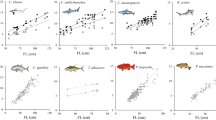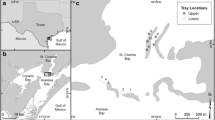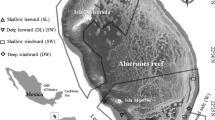Abstract
Parrotfishes are a group of herbivores that play an important functional role in structuring benthic communities on coral reefs. Increasingly, these fish are being targeted by fishermen, and resultant declines in biomass and abundance may have severe consequences for the dynamics and regeneration of coral reefs. However, the impact of overfishing extends beyond declining fish stocks. It can also lead to demographic changes within species populations where mean body size is reduced. The effect of reduced mean body size on population dynamics is well described in literature but virtually no information exists on how this may influence important ecological functions. The study investigated how one important function, scraping (i.e., the capacity to remove algae and open up bare substratum for coral larval settlement), by three common species of parrotfishes (Scarus niger, Chlorurus sordidus, and Chlorurus strongylocephalus) on coral reefs at Zanzibar (Tanzania) was influenced by the size of individual fishes. There was a non-linear relationship between body size and scraping function for all species examined, and impact through scraping was also found to increase markedly when fish reached a size of 15–20 cm. Thus, coral reefs which have a high abundance and biomass of parrotfish may nonetheless be functionally impaired if dominated by small-sized individuals. Reductions in mean body size within parrotfish populations could, therefore, have functional impacts on coral reefs that previously have been overlooked.


Similar content being viewed by others
References
Bellwood DR, Choat JH (1990) A functional analysis of grazing in parrotfishes (family Scaridae): the ecological implications. Environ Biol Fish 28:189–214
Bellwood DR, Hoey AS, Choat JH (2003) Limited functional redundancy in high diversity systems: resilience and ecosystem function on coral reefs. Ecol Lett 6:281–285
Bellwood DR, Hughes TP, Folke C, Nyström M (2004) Confronting the coral reef crisis. Nature 429:827–833
Bellwood DR, Hughes TP, Hoey AS (2006) Sleeping functional group drives coral reef recovery. Curr Biol 16:2434–2439
Berkeley SA, Chapman C, Sogard SM (2004) Maternal age as a determinant of larval growth and survival in a marine fish, Sebastes melanops. Ecology 85:1258–1264
Blanckenhorn WU (2000) The evolution of body size: what keeps organisms small? Q Rev Biol 75:385–407
Bruggemann JH, van Kessel AM, van Rooij JM, Breeman AM (1996) Bioerosion and sediment ingestion by the Caribbean parrotfish Scarus vetula and Sparisoma viride: implications of fish size, feeding mode and habitat use. Mar Ecol Prog Ser 134:59–71
Carlton JT, Geller JB, Reaka-Kudla ML, Norse EA (1999) Historical extinctions in the sea. Annu Rev Ecol Syst 30:515–538
Carpenter RC (1986) Partitioning herbivory and its effects on coral reef algal communities. Ecol Monogr 56:345–363
Choat JH, Robertson DR (2002) Age-based studies. In: Sale PF (ed) Coral reef fishes: dynamics and diversity in a complex ecosystem. Academic Press, San Diego, pp 57–80
Done TJ (1992) Phase shifts in coral reef communities and their ecological significance. Hydrobiologia 247:121–132
Dulvy NK, Freckleton RP, Polunin NVC (2004) Coral reef cascades and the indirect effects of predator removal by exploitation. Ecol Lett 7:410–416
Evans RD, Russ GR, Kritzer JP (2008) Batch fecundity of Lutjanus carponotatus (Lutjanidae) and implications of no-take marine reserves on the Great Barrier Reef, Australia. Coral Reefs [doi: 10.1007/s00338-007-0309-8]
Fox RJ, Bellwood DR (2007) Quantifying herbivory across a coral reef depth gradient. Mar Ecol Prog Ser 339:49–59
Froese R, Pauly D (2005) FishBase. World Wide Web electronic publication. www.fishbase.org, version (01/2005)
Hatcher BG (1984) A maritime accident provides evidence for alternate stable state in benthic communities on coral reefs. Coral Reefs 3:199–204
Hawkins JP, Roberts CM (2003) Effects of fishing on sex-changing Caribbean parrotfishes. Biol Conserv 115:213–226
Hixon MA, Brostoff WN (1996) Succession and herbivory: effects of differential fish grazing on Hawaiian coral reef algae. Ecol Monogr 66:67–90
Hughes TP (1994) Catastrophes, phase-shifts, and large-scale degradation of a Caribbean coral reef. Science 265:1547–1551
Hughes TP, Baird AH, Bellwood DR, Card M, Connolly SR, Folke C, Grosberg R, Hoegh-Guldberg O, Jackson JBC, Kleypas J, Lough JM, Marshall P, Nyström M, Palumbi SR, Pandolfi JM, Rosen B, Roughgarden J (2003) Climate change, human impacts, and the resilience of coral reefs. Science 301:929–933
Hughes TP, Bellwood DR, Folke C, Steneck RS, Wilson J (2005) New paradigms for supporting the resilience of marine ecosystems. Trends Ecol Evol 20:380–386
Hughes TP, Bellwood DR, Folke CS, McCook LJ, Pandolfi JM (2007) No-take areas, herbivory and coral reef resilience. Trends Ecol Evol 22:1–3
Jackson JBC, Kirby MX, Berger WH, Bjorndal KA, Botsford LW, Bourque BJ, Bradbury RH, Cooke R, Erlandson J, Estes JA, Hughes TP, Kidwell S, Lange CB, Lenihan HS, Pandolfi JM, Peterson CH, Steneck RS, Tegner MJ, Warner RR (2001) Historical overfishing and the recent collapse of coastal ecosystems. Science 293:629–638
Jompa J, McCook LJ (2002) Effects of competition and herbivory on interactions between a hard coral and a brown alga. J Exp Mar Biol Ecol 271:25–39
Love MS, Johnson K (1999) Aspects of the life histories of grass rockfish, Sebastes rastrelliger, and brown rockfish, S. auriculatus, from southern California. Fish Bull 97:100–109
McClanahan TR, Graham NAJ, Calnan JM, MacNeil MA (2007) Toward pristine biomass: reef fish recovery in coral reef marine protected areas in Kenya. Ecol Appl 17:1055–1067
McClanahan TR, McField M, Huitric M, Bergman K, Sala E, Nyström M, Nordemar I, Elfwing T, Muthiga NA (2001) Responses of algae, corals and fish to the reduction of macroalgae in fished and unfished patch reefs of Glovers Reef Atoll, Belize. Coral Reefs 19:367–379
Meester GA, Mehrotra A, Ault JS, Baker EK (2004) Designing marine reserves for fishery management. Manag Sci 50:1031–1043
Mumby (2006) The impact of exploiting grazers (Scaridae) on the dynamics of Caribbean coral reefs. Ecol Appl 16:747–769
Mumby PJ, Dahlgren CP, Harborne AR, Kappel CV, Micheli F, Brumbaugh DR, Holmes KE, Mendes JM, Broad K, Sanchirico JN, Buch K, Box S, Stoffle RW, Gill AB (2006) Fishing, trophic cascades, and the process of grazing on coral reefs. Science 311:98–101
Mumby PJ, Harborne AR, Williams J, Kappel CV, Brumbaugh DR, Micheli F, Holmes KE, Dahlgren CP, Paris CB, Blackwell PG (2007) Trophic cascade facilitates coral recruitment in a marine reserve. Proc Natl Acad Sci USA 104:8362–8367
Munro JL (1983) The composition and magnitude of trap catches in Jamaican waters. In: Munro JL (ed) Caribbean coral reef fishery resources. ICLARM Studies and Reviews 7. Makati, Philippines, pp 33–49
Myers RA, Worm B (2003) Rapid worldwide depletion of predatory fish communities. Nature 423:280–283
Nyström M, Folke C, Moberg F (2000) Coral reef disturbance and resilience in a human-dominated environment. Trends Ecol Evol 15:413–417
Pauly D, Christensen V, Dalsgaard J, Froese R, Torres F (1998) Fishing down marine food webs. Science 279:860–863
Pauly D, Christensen V, Guenette S, Pitcher TJ, Sumaila UR, Walters CJ, Watson R, Zeller D (2002) Towards sustainability in world fisheries. Nature 418:689–695
Petersen CW, Warner RR (2002) The ecological context of reproductive behavior. In: Sale PF (ed) Coral reef fishes: Dynamics and diversity in a complex ecosystem. Academic Press, San Diego, pp 103–118
Riedmiller S (1998) The Chumbe Island Coral Park Project: Management experiences of a private marine conservation project. International Tropical Marine Ecosystems Management Symposium (ITMEMS). Great Barrier Reef Marine Park Authority, Townsville, pp 222–235
Russ GR (1991) Coral reef fisheries: effects and yields. In: Sale PF (ed) The ecology of fishes on coral reefs. Academic Press, London, pp 601–635
Sale PF, Cowen RK, Danilowicz BS, Jones GP, Kritzer JP, Lindeman KC, Planes S, Polunin NVC, Ruse GR, Sadovy YJ, Steneck RS (2005) Critical science gaps impede use of no-take fishery reserves. Trends Ecol Evol 20:74–80
Scheffer M, Carpenter S, Foley JA, Folke C, Walker B (2001) Catastrophic shifts in ecosystems. Nature 413:591–596
Shin YJ, Rochet MJ, Jennings S, Field JG, Gislason H (2005) Using size-based indicators to evaluate the ecosystem effects of fishing. ICES J Mar Sci 62:384–396
Steneck RS (1988) Herbivory on coral reefs: a synthesis. Proc 6th Int Coral Reef Symp 1:37–49
Williams ID, Polunin NVC, Hendrick VJ (2001) Limits to grazing by herbivorous fishes and the impact of low coral cover on macroalgal abundance on a coral reef in Belize. Mar Ecol Prog Ser 222:187–196
Acknowledgments
We would like to thank DR Bellwood for valuable comments on the manuscript and N Jiddawi (MSI, University of Dar es Salaam), M Peterson, and H Peeks (CHICOP) for their kind support. The field work of J L was supported by L & E Kinanders foundation. The work of MN, MT, and CJ was supported by the Swedish International Development Cooperation Agency (Sida/Sarec).
Author information
Authors and Affiliations
Corresponding author
Additional information
Communicated by Biology Editor Dr Mark McCormick
Rights and permissions
About this article
Cite this article
Lokrantz, J., Nyström, M., Thyresson, M. et al. The non-linear relationship between body size and function in parrotfishes. Coral Reefs 27, 967–974 (2008). https://doi.org/10.1007/s00338-008-0394-3
Received:
Revised:
Accepted:
Published:
Issue Date:
DOI: https://doi.org/10.1007/s00338-008-0394-3




